
from the


from the
Sound to the

The Skagit River begins in the Cascade Mountains of British Columbia and meets the Puget Sound roughly 60 miles north of Seattle. The river stretches nearly 160 miles through the peaks of Mount Baker and Glacier Peak. Its tributaries, the Sauk, Suiattle and Cascade rivers help make up a a unique and delicate ecosystem that serves people, wildlife and habitat. Eight miles above its mouth to Skagit Bay, the main river is separated into two principal channels called the North and South forks, with Fir Island resting between them.
The Skagit River is named after the Skagit People. Before Europeans arrived, the Upper Skagit Tribe occupied the lands along the Skagit, Baker and Sauk rivers and the Lower Skagit Tribe lived in the Whidbey Island area near the mouth of the river. The river was a source of life for these people.

“The Upper Skagit Tribe dwelled in longhouses, scattered all over the banks of the Skagit River. Remains can be dated back 8500 years. The tribe was primarily known for fishing and small-time game hunting. Their cultural patterns follow those of salmon migration upstream.” (Colorado College, Feb. 21, 2023)
Today, the region is still home to the Upper Skagit, Swinomish and Sauk-Suiattle tribes. For thousands of years, these tribes had a culture that centered around river and saltwater resources. In 1855, the area tribes signed the Treaty of Point Elliott, which guaranteed them certain hunting and fishing rights.
European settlement of the area began in earnest in the 1860s and the new people realized that the floodplain of the Skagit River Delta held some of the world’s most promising farmland. But the settlers needed to control the flooding and tidal cycle that regularly occurred on the delta in order to use the land. They worked for years to dike and drain the wetlands, building farms and working the area with teams of horses and brute strength. Many of them understood how to convert marshes into farmland from their experiences in their homelands of Scan dinavia. The delta became roughly 90,000 acres of protected farmland behind miles of dikes and drain age ditches. “In 1895, the Washington State Legis lature allowed landowners to organize into diking districts, which were responsible for maintaining the dikes and protecting the farmland behind them (Historylink, Farming in the Skagit Valley, 2021). Us ing tidegates and drainage ditches, landowners were able to manage the influx of tidal waters and flooding from the river. Oats, hay, barley and pota toes were the predominant crops during the early years, and vegetable seeds and bulb flowers later became mainstays as well. The area’s soil has prov en to be among the best in the world, and Skagit County maintains one of the largest and most di verse agricultural communities west of the Cascade Mountains. Known for spinach seed, potatoes and tulips, local farms produce about $300 million worth of crops, livestock and dairy products.


The river over the years, however, has proven un manageable at times, with flooding affecting the region throughout the decades. Flooding contin ues to be a major concern for landowners and pol icymakers. The local Upper Skagit, Swinomish and Sauk-Suiattle tribes have also been working with local landowners and the state for decades to ensure their rights to salmon fishing are upheld amidst the decline in salmon populations along the entire west coast of Canada and the U.S. The management of this unique river’s ecosystem requires balance and provides local food to the greater Seattle region.
Keeping the ecosystem healthy is the priority of all involved in its management, including landowners, local policy leaders and tribes. This river system exemplifies the necessary respect and determination between neighbors to protect agriculture and tribal fishing rights.


It’s hard to imagine that nearly 150 years ago, some of the most fertile farmland in the state was once hindered by a logjam more than a mile long.


“In the summer of 1876, partners Joe Wilson and Donald McDonald begin removing a massive logjam on the Skagit River. For nearly 100 years, its lower section, located a half mile below the fledging town of Mount Vernon, has blocked the flow of 'ordinary' river traffic upstream. A rude skid road built by Upper Skagit Indians to haul their canoes around the jam is the only way around it.” (Historylink, Workers begin removing a logjam, 2004)


The logjam occurred naturally long before Europeans arrived, and it took three years to clear the jam sufficiently to allow navigation up and down the river. A memorial was dedicated in 1999 with four large, black, metal cutouts depicting the loggers sawing, chopping, prying and winching the massive logs that impeded the flow of people and goods from the interior of the Skagit Valley to Skagit Bay.


From Holland roots to high-tech greenhouses, the Roozen family's passion for tulip bulbs and cut flowers continues to grow.

When you think of farming and agriculture, you probably think of cash crops like potatoes, wheat or corn. Washington is well known for its agricultural diversity, and that includes nonedible commodities as well. Washington Bulb Co. is a family-owned and -operated flower farm in Skagit County. The largest tulip bulb grower in the country, Washington Bulb Co. sells bulbs and cut flowers to large grocery store chains and wholesale distributors all over the United States.
The Roozen family has a centuries-old heritage in growing flower bulbs. The family began growing tulips in Holland in the mid-1700's and emigrated to the Skagit Valley in 1947. The Roozen family started Washington Bulb Co. and Roozengaarde in 1985, and have built a business that is world-renowned. Over the years, the Roozens have built and installed 16 high-tech glass greenhouses to facilitate flower production all year long. They have also planted and maintained over 1,000 acres of flowers that cover the Skagit Valley in brilliant color. Growing flowers is in their blood, and it shows by the incredible volume and quality of flowers they ship across the country each day.

Ben Roozen, a third-generation flower farmer at Washington Bulb Co., can trace his roots all the way to Holland where the Roozens have grown tulips for many generations before him. “Tulips are obviously synonymous with the name Roozen,” he says. “Interestingly enough, Roozen means rose in Dutch. There’s some irony there.” Not only does Washington Bulb Co. grow tulips, but also irises and daffodils.
Leo Roozen, the lead grower, is a sixth-generation tulip grower. “We grow cut flowers 52 weeks out of the year, and so we’re in the greenhouses year-round.” The greenhouses are designed with multiple different watering systems, temperature controls, and ventilation systems to keep foliage dry. Once flowers are mature and ready for harvesting, the bulbs are cut off, and the fresh flowers are sold and shipped to customers all over. To maintain a steady supply of flowers, bulbs are started and “forced” to a specific growth stage, at which they are frozen for storage. Then, bulbs can be pulled from storage and planted when a new stand of flowers is ready to be transitioned into the greenhouses. Within 12 days, fresh flowers are ready to be cut, packaged and shipped.
similar conditions to that of the Skagit Valley. When the Roozen family arrived in the area nearly three generations ago,






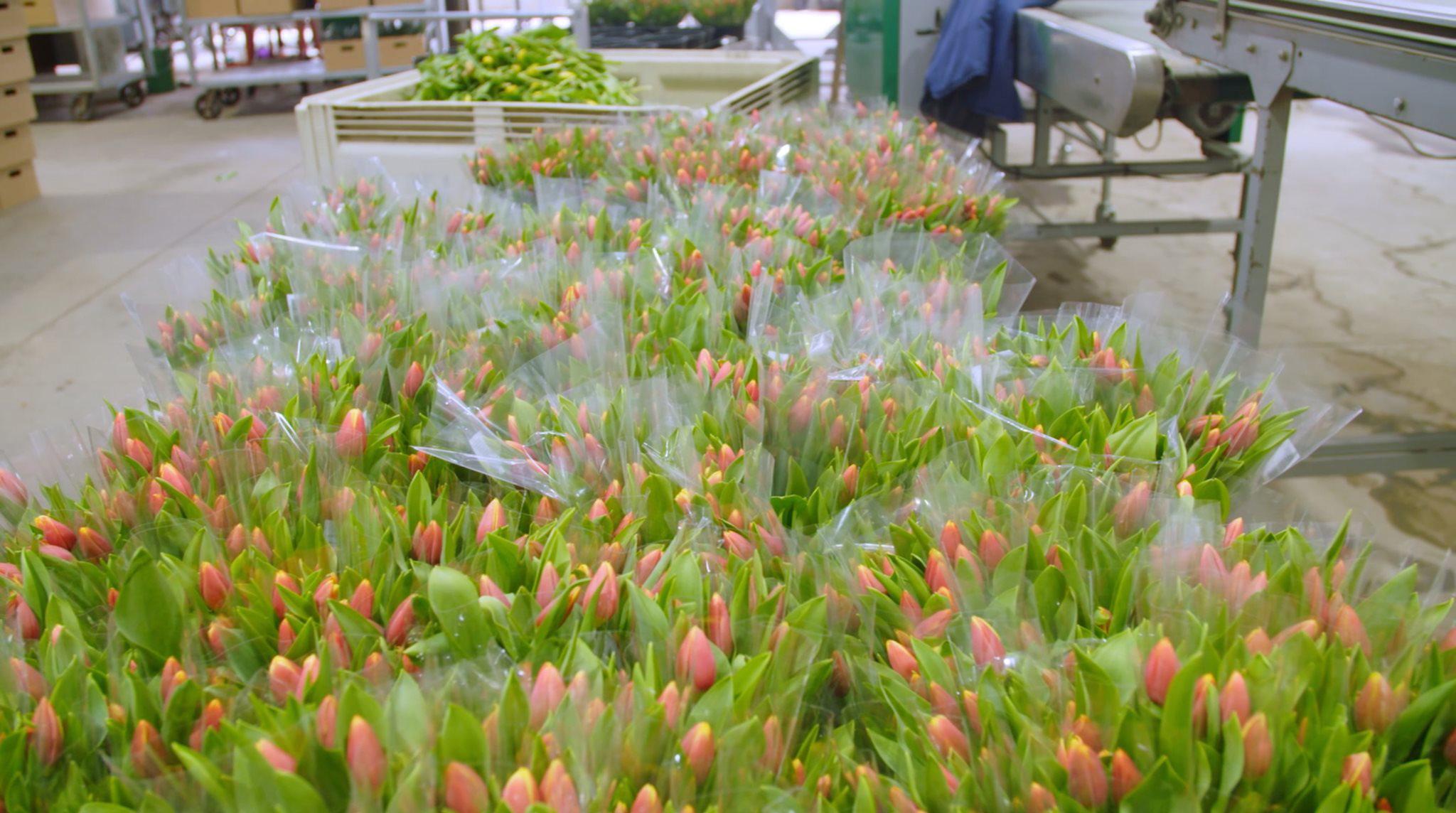


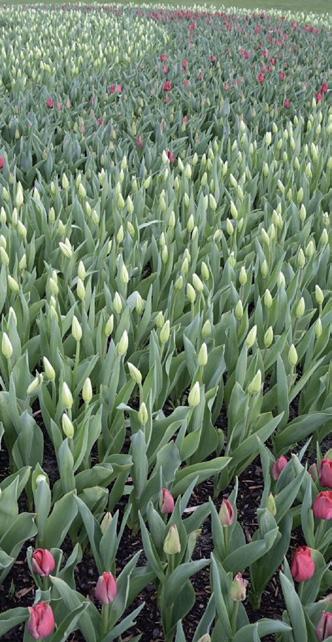




KSPS (Spokane)


Mondays at 7:00 pm and Saturdays at 4:30 pm ksps.org/schedule/
KWSU (Pullman)
Fridays at 6:00 pm nwpb.org/tv-schedules/
KTNW (Richland)
Saturdays at 1:00 pm nwpb.org/tv-schedules

KBTC (Seattle/Tacoma)


Saturdays at 6:30 am and 3:00 pm kbtc.org/tv-schedule/
KIMA (Yakima)/KEPR (Pasco)/KLEW (Lewiston)
Saturdays at 5:00 pm kimatv.com/station/schedule / keprtv.com/station/schedule klewtv.com/station/schedule
KIRO (Seattle)




Saturdays at 7:30 am and Mondays at 2:30 pm or LiveStream Saturdays at 2:30 pm on kiro7.com kiro7.com



NCW Life Channel (Wenatchee) Check local listings ncwlife.com
RFD-TV
Thursdays at 12:30 pm and Fridays at 9:00 pm (Pacific) rfdtv.com/

*Times/schedules subject to change based upon network schedule. Check station programming to confirm air times.

Danish Ingredients
1 lb store-bought all-butter puff pastry, thawed
1 egg

2 teaspoons water
Mixed summer berries, for serving Edible flowers, for serving Powdered sugar, for serving
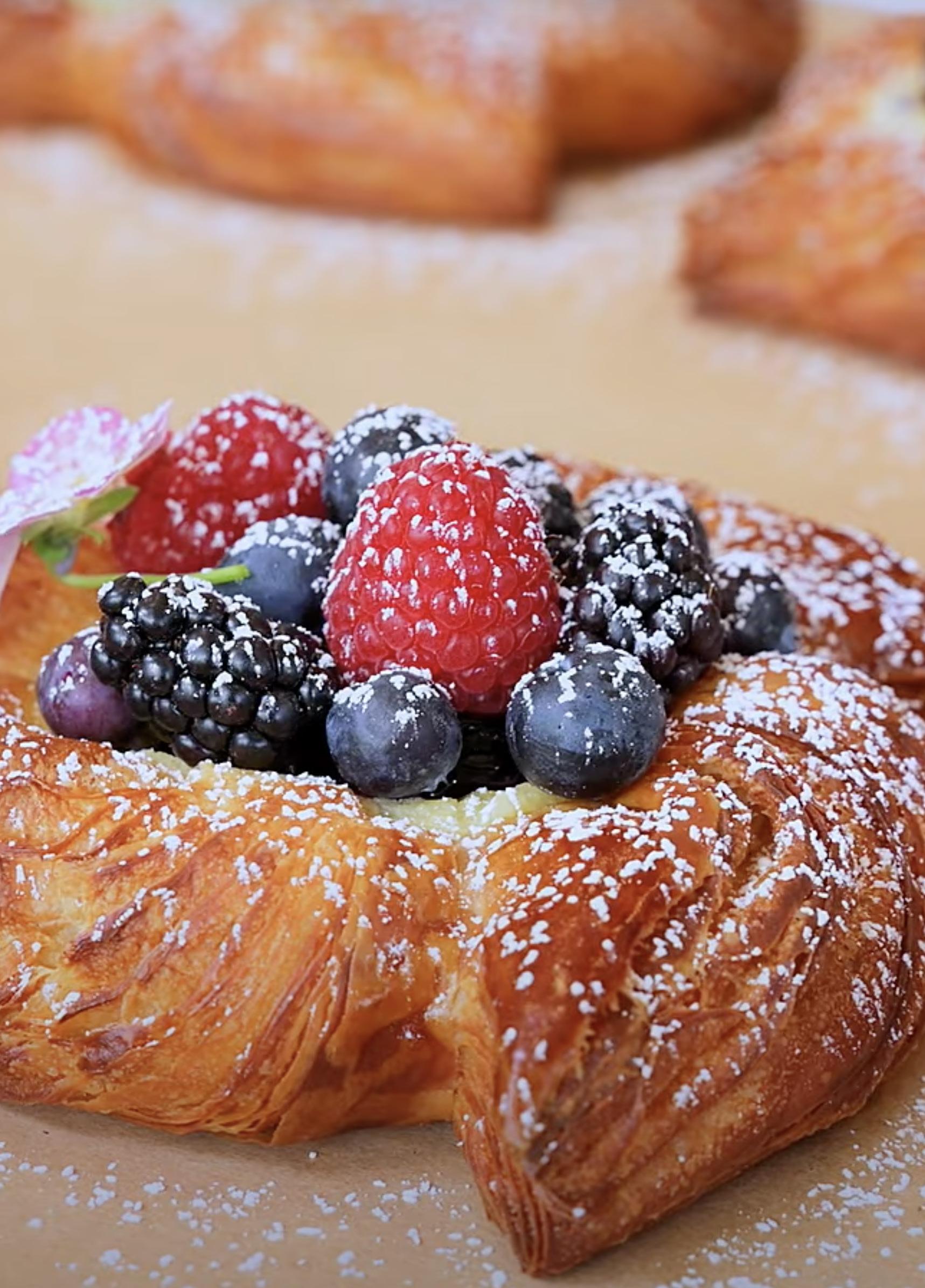
The Flora Bakehouse berry danish, featured on Episode 2 of Washington Grown season 10, begins with rich yeasted dough that has a touch of aromatic cardamom. This shortcut version uses store-bought puff pastry instead. You will definitely want to visit the bakery for the original when local berries are in season.
1 cup whole milk
2 fresh bay leaves
3 tablespoons sugar, divided
2 egg yolks
2 tablespoons cornstarch
Pinch salt
1 1/2 tablespoons unsalted butter, cut into pieces, softened
For the berry jam, put half the berries in a medium saucepan and use a potato masher to crush them. Add the remaining berries, sugar and lemon juice and stir with a heat-proof rubber spatula. Cook over medium-low heat for a few minutes until the sugar dissolves, stirring occasionally. Increase the heat to medium and cook, stirring frequently, until the mixture begins to thicken, about 15 minutes. It may bubble up; reduce the heat a bit if needed. Use the spatula to scrape the bottom and sides as you stir to avoid sticking. Taste the jam and adjust with more lemon juice or sugar if needed. Continue to cook until the jam is thick and shiny, about 5 minutes longer. Transfer to a bowl and let cool, then cover and refrigerate until needed.
For the pastry cream, combine the milk and bay leaves in a small saucepan and bring to a simmer over medium heat. Set aside to steep, covered, for 30 minutes. Remove the bay leaves, add half of the sugar, and stir over medium heat until the sugar is dissolved. Take the pan from the heat.
Put the egg yolks in a medium bowl. In a small bowl, whisk together the remaining sugar, cornstarch and salt. Add this to the egg yolks and whisk to blend. Whisk about one quarter of the warm milk into the egg yolk mixture until smooth, then gradually add this to the saucepan, whisking constantly. Cook over medium-low heat, whisking constantly, until the mixture just comes to a boil and begins to thicken, 3 to 5 minutes. Reduce the heat to low and keep whisking for 2 minutes as it
1 pound mixed summer berries, rinsed and well dried
3/4 cup sugar, more if needed
1 teaspoon freshly squeezed lemon juice, more if needed
continues to thicken. Take the pan from the heat and whisk in the butter pieces until smooth. Transfer to a bowl, lay plastic wrap directly on the surface of the pastry cream, and set aside to cool. When cool, refrigerate until needed.
Preheat the oven to 375 F. Line a baking sheet with a silicone baking mat or parchment paper.
Cut the puff pastry dough into 4-inch squares. From each corner on the squares, make a 1 1/2-inch slit toward the center. Fold one of the corner points down nearly to the center and press gently to adhere. Fold the same side of the other corners down in the same way, creating a pinwheel.
Set the pinwheels on the baking sheet at least 1 inch apart (bake in 2 batches if needed) and use your fingertips to press the centers a bit thinner. Combine the egg and water in a small bowl, blend well with a fork, and brush this lightly on the pastries. Add a generous 1 tablespoon of pastry cream to the center of each pinwheel. Bake for 10 minutes, then lower the oven temperature to 325 F and bake until the pastry is well browned, 35 to 40 minutes longer. Transfer to a wire rack to cool.
To serve, spoon a generous teaspoon of jam over the pastry cream. Top the jam with fresh berries and edible flowers, then finish with a light dusting of powdered sugar.
Located in the Beacon Hill neighborhood of Seattle, Flora Bakehouse is a paradise for anyone with a sweet tooth. The owner, Nat Stratton-Clarke, wanted to create a special place where customers could escape their daily routine and indulge in some delicious pastries and coffee.
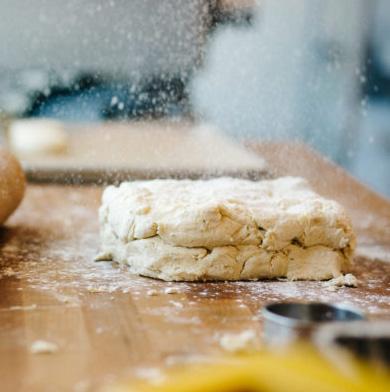
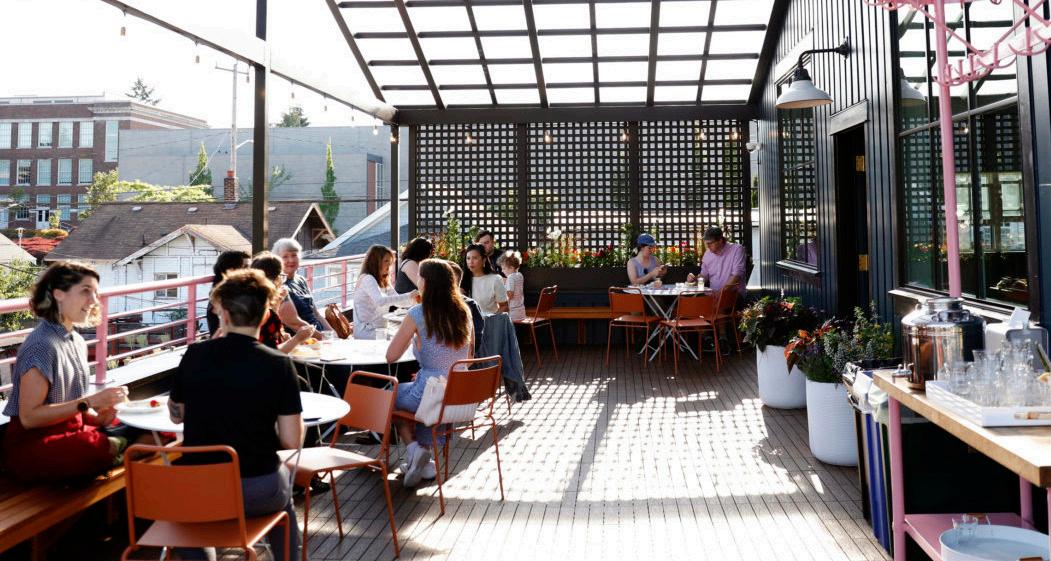
The name of the bakery perfectly matches its ambiance. Flora, which means "flowers" in Latin, is home to an array of flowers grown on its rooftop garden. The bakery's interior is decorated with colorful flowers, creating an environment that feels like springtime in the Northwest. Customers rave about the bakery's welcoming aesthetic, which feels both homey and airy.
"I think so often kitchens are tucked in the back of a bakery. You never see the person that's actually making the food you're eating," said Stratton-Clarke. "These people are artisans. They're craftspeople. It's so fun to see these kids plastered up against the window, just watching the magic. Just take butter and flour and turn it into a chocolate croissant – again, as an adult, I think it's magic."
Flora Bakehouse's menu is not limited to pastries, bread and coffee. The bakery highlights seasonal produce and offers seasonal Danish pastries that are perfect for showcasing the variety of berries grown in Washington. Washingtonians are lucky to have access to an array of berries that are not commonly found elsewhere. This makes every visit to Flora Bakehouse a unique and delightful experience.
"The baguette is among the best I've had in Seattle," said one customer. "I'm here about four times a week."

Flora Bakehouse is not just a bakery, it is a destination. The bakery's porch is adorned with flowers, and customers can sit outside and enjoy their pastries and coffee while basking in the beauty of the surroundings. The bakery's roof deck is another perfect spot for customers to sit and enjoy their food while gazing at the breathtaking views of Mt. Rainier.
From its beautiful interior, fresh flowers, seasonal pastries, and top-quality baked goods, there is something for everyone at Flora Bakehouse.







The tulip industry got its start in Holland. In the 1500s, Carolus Clusius, a botanist at the University of Leiden in the Netherlands, received some tulip bulbs from the ambassador to the sultan. Clusius grew the plants in his private collection, but he would not share his bulbs or sell them. As a result, the gardens were repeatedly raided, and the bulbs sold. Holland’s tulip industry was born.


Spring is a magical time in Skagit Valley. Crops are flourishing, livestock of all sizes bring new babies to the herd, and fields of flowers begin to bloom. The annual Skagit Valley Tulip Festival is held every April when row after row of perfect flowers are at their peak beauty. Thousands of people come to take in the incredible views and experience the floral festivities.
First stop, RoozenGaarde. Owned and operated by Washington Bulb Co., this fiveacre display garden is bursting with color and life. You won’t just find tulips blooming at RoozenGaarde, but also daffodils, lilies and peonies, too. Like many agricultural crops, tulips require a lengthy rotation between plantings, allowing RoozenGaarde to produce a wide variety of flowers. First in Holland and now in the Skagit Valley, the Roozen family has worked for decades to build RoozenGaarde and play a key role in the Northwest flower industry.
Flower producers like the Roozen family and other Skagit Valley locals dedicate their time and talents to making the annual tulip festival a success. Showcasing their hard work and collaboration each year is just one of the rewarding parts of being a part of this industry. Visitors can get their day on the farm and enjoy a wide array of activities along the way. You may come for the nearly 70 varieties of flowers, but you’ll stay for the picture-perfect photo ops, trolley rides, and beer and wine garden at Tulip Town before heading to a local street fair in downtown Mount Vernon.

While agriculture is a major economic driver in the region, tourism also contributes greatly. The annual tulip festival can bring anywhere from 15,000 to 40,000 visitors to the Skagit Valley each year. The communities in the area come together to not only put on a beautiful event for tourists, but also to support one another. Farmers, artists, bakers, chefs, florists and so many more Skagit Valley locals benefit from the flower madness that descends upon the valley each spring.
The annual tulip festival is a bucket-list item that everyone should attempt to check off. A pride of the Pacific Northwest, the Skagit Valley offers many incredible destinations and experiences. It’s impossible to witness the beauty of the valley without a smile on your face. Acre upon acre of vibrant tulips will lay before you; the contagious energy of the season is sure to infect you after a day at the tulip festival.

Everyone should grow at least a few flowers around your home. Trust me, you'll be glad that you did. Lets talk about flowers, and how to make a beautiful arrangement with them.

Where do you start?
When you do an arrangement, you're going to want to start with your focal flower, the one that is the center of the whole thing. We're just going to start adding in some other flowers to complement and highlight this one.
What flowers are good for an arrangement?
Any flowers will work! You just want to make sure to grab them when they're maybe not quite that fully open, when they're really, really close, because that's going to provide longevity, too. If you get in when they're already completely full bloom, then your bouquet is not going to last near as long.
What can you do to make your arrangement last longer?
The biggest thing you want to fight is the fungus and stuff, the molds and things that can get in there, kind of ruin the stands and turn the water and make it all stinky. The best thing to do for that is going to be some vodka and baking soda. They act as an antifungal. Then you're just going to take it, and you're just going to swish a little bit so it gets all around, and it just stirs it up a little.
The Washington Grown project is made possible by the Washington State Department of Agriculture and the USDA Specialty Crop Block Grant program, through a partnership with the state’s farmers.

Marketing Director
Brandy Tucker
Editor
Kara Rowe
Assistant Editor
Trista Crossley
Art Designers
Jon Schuler
Writers
Maya Aune
Bailey Meacham
Kara Rowe
Cynthia Nims
Images
Flora Bakehouse Shutterstock
Washington State Historical Society
Spokane County Library
Washington Grown

Executive Producers
Kara Rowe
David Tanner
Chris Voigt
Producers
Ian Loe
Sydney Nelson
Hosts
Kristi Gorenson
Tomás Guzmán
Val Thomas-Matson